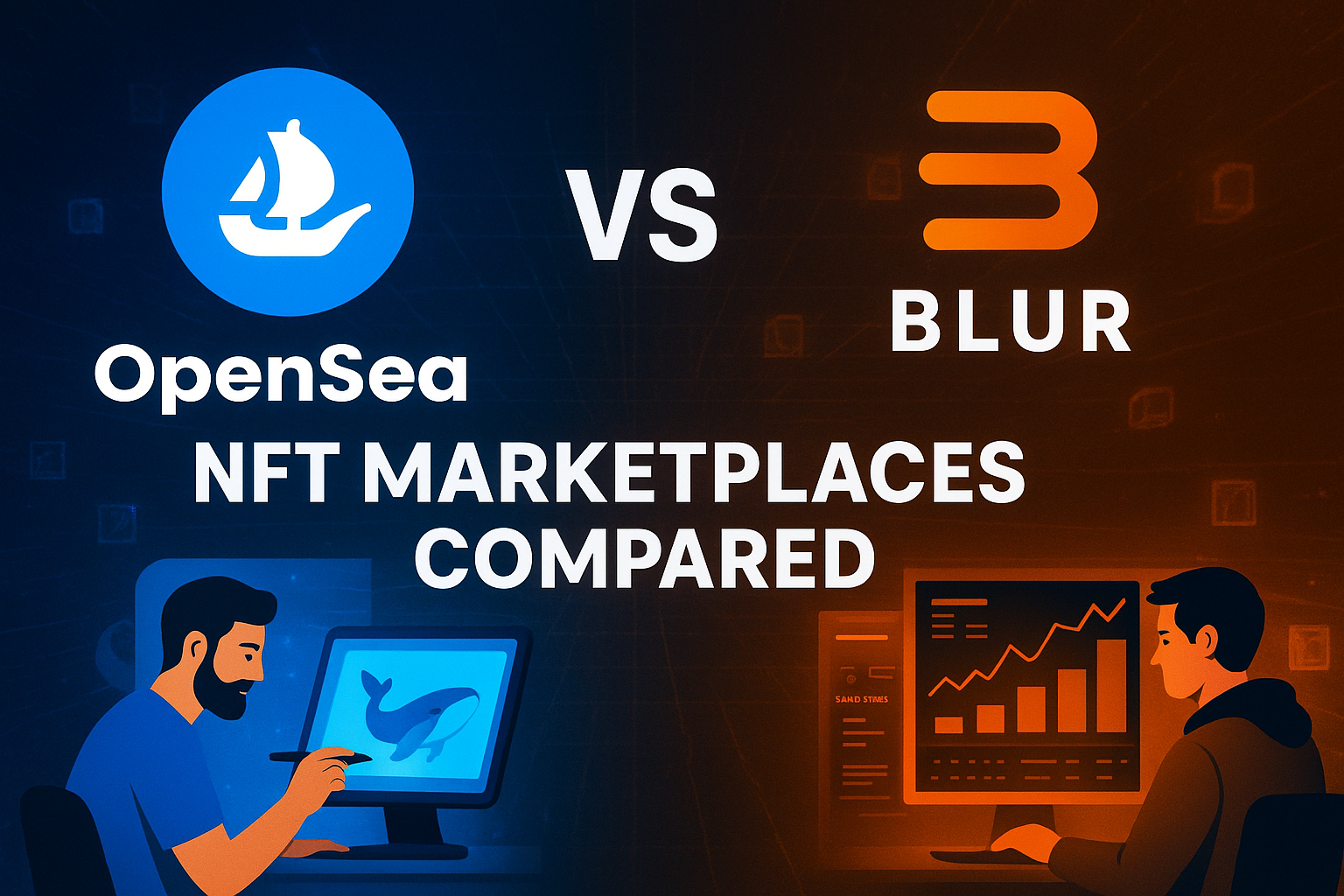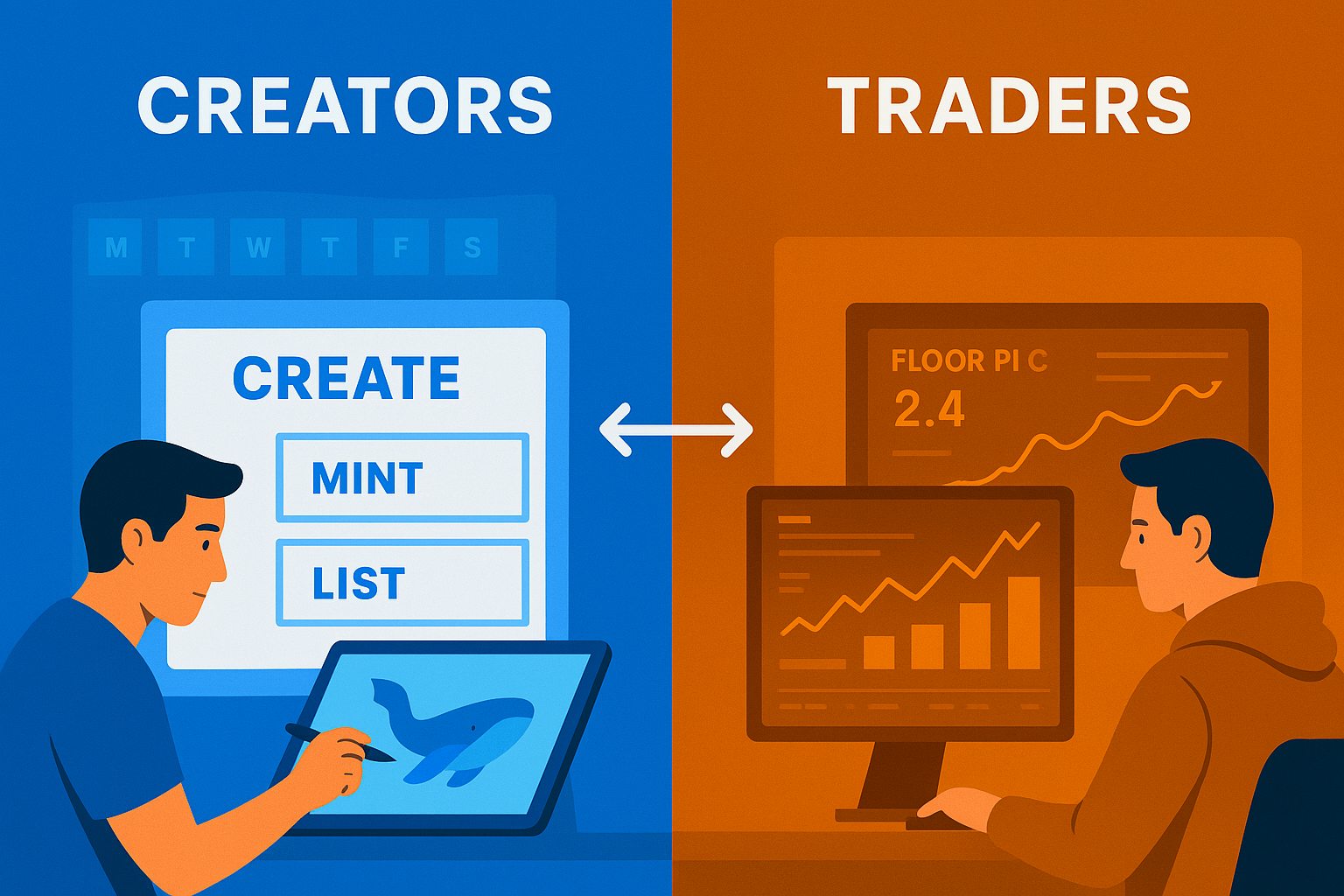OpenSea vs Blur: What to Choose for Creators and Collectors
In the rapidly evolving NFT ecosystem, two marketplaces dominate the conversation — OpenSea and Blur. Both have reshaped how creators mint and sell NFTs, and how collectors trade them. But they cater to different audiences, with unique philosophies, interfaces, and reward systems. This article breaks down their core differences to help you decide which platform best suits your goals — whether you’re a digital artist, project founder, or NFT trader.

The Philosophies: A Tale of Two Titans
OpenSea: The Gateway and The Gallery
Launched in 2017, OpenSea is the O.G. It's the platform that brought NFTs to the masses. Think of it as the grand, welcoming museum of the NFT world. It's designed for discovery, browsing, and storytelling. Its strength lies in its simplicity, massive brand recognition, and support for a wide array of blockchains, including Ethereum, Polygon, and Solana.
Blur: The Trading Floor for Pros
Blur arrived in late 2022 with a clear mission: serve the professional trader. It’s the high-speed, multi-screen trading terminal. From day one, it prioritized speed, zero fees, and advanced analytics, quickly capturing the lion's share of trading volume by catering to whales and high-frequency flippers.
User Interface and Experience
Aspect | OpenSea | Blur |
|---|---|---|
Design | Clean, visual, beginner-friendly | Minimalist, data-driven |
Speed | Moderate, optimized for browsing | Extremely fast — built for bulk trading |
Analytics | Basic collection stats | Advanced real-time charts, floor tracking, and portfolio tools |
Audience | General users, creators, casual collectors | Pro traders, NFT flippers, analytics-driven users |
Verdict: OpenSea is better for creators and casual collectors seeking accessibility. Blur wins for advanced traders who need precision, data, and speed.
Creator Tools and Royalties
OpenSea was built around supporting creators. Artists can mint directly on the platform without coding, set royalties, and showcase collections easily. However, the platform faced backlash when it made creator royalties optional in 2023, reducing guaranteed earnings for many artists.
Blur takes a different approach: it allows creators to enforce royalties through smart contracts but focuses primarily on trading liquidity. It rewards traders with BLUR tokens for activity — but that system often benefits high-volume traders more than original creators.
Verdict: For creators who prioritize royalties and discoverability, OpenSea remains the safer option. For creators aligned with a more decentralized, competitive market, Blur offers visibility among active traders — but with less control over revenue streams.
Fees & Rewards: The Profitability Equation
This is where Blur's value proposition becomes crystal clear for traders.
OpenSea:
Marketplace Fee: 2.5% on every sale.
Rewards: None. You get what you sell.
Blur:
Marketplace Fee: 0%. You only pay gas.
Rewards: Traders earn $BLUR tokens for listing, bidding, and overall activity through seasonal airdrops. This can significantly subsidize trading costs.
The Verdict: For pure trading profitability, Blur is the undisputed winner. The 0% fee model alone saves high-volume traders thousands.
Liquidity and Market Depth
Blur’s aggregated marketplace model pulls listings from multiple sources, including OpenSea itself, giving traders access to broader liquidity and better price discovery. It also offers bulk listing, sweeping, and bidding functions — ideal for whale-level trading.
OpenSea’s liquidity comes from its massive user base, but listings are often slower to update, and there’s less arbitrage flexibility.
Verdict: For large-scale trading and liquidity depth, Blur is unmatched. For organic, community-driven sales, OpenSea still feels more authentic.
Security and Trust
Both platforms have suffered from phishing campaigns, but technically, both maintain robust contract security and verification systems.
OpenSea uses rigorous collection verification and freeze functions for stolen NFTs.
Blur integrates with Delegate Cash, allowing safe trading without exposing private wallets.
Verdict: Both are relatively secure, but OpenSea’s longer track record and moderation tools make it slightly more reliable for newcomers.
Token and Ecosystem
OpenSea has no native token, focusing on building trust through usability and partnerships.
Blur, however, operates with its governance and reward token — $BLUR, which powers its ecosystem and gives holders voting rights on protocol upgrades. It’s an essential part of Blur’s strategy to decentralize governance and attract long-term traders.
Verdict: If you want to be part of a token-driven ecosystem and earn while trading, Blur provides a clear advantage. OpenSea focuses more on simplicity and broad adoption.

Which Platform Should You Choose?
If You’re a Creator:
Choose OpenSea for:
Easy minting and listing process
Better discoverability
Familiar UX for newcomers
Proven market trust
Choose Blur for:
Exposure to active traders
Dynamic liquidity pools
Potential token rewards (if you engage in trading too)
If You’re a Collector or Trader:
Choose OpenSea for:
Stable and intuitive experience
Verified collections and safety filters
Choose Blur for:
Advanced tools for flipping and analytics
Zero trading fees
High-speed execution and token incentives
Final Thoughts
The NFT market no longer has a one-size-fits-all platform. OpenSea remains the entry point for most of the community — a place where creators build reputation and collectors explore art. Blur has established itself as the professional’s marketplace, with an emphasis on data, rewards, and liquidity.
Ultimately, many NFT users now use both:
OpenSea for minting, showcasing, and discovery.
Blur for active trading and maximizing returns.
As the ecosystem matures, the synergy between creator-driven and trader-driven models might define the future of NFTs — not competition, but coexistence.
Recent comments
